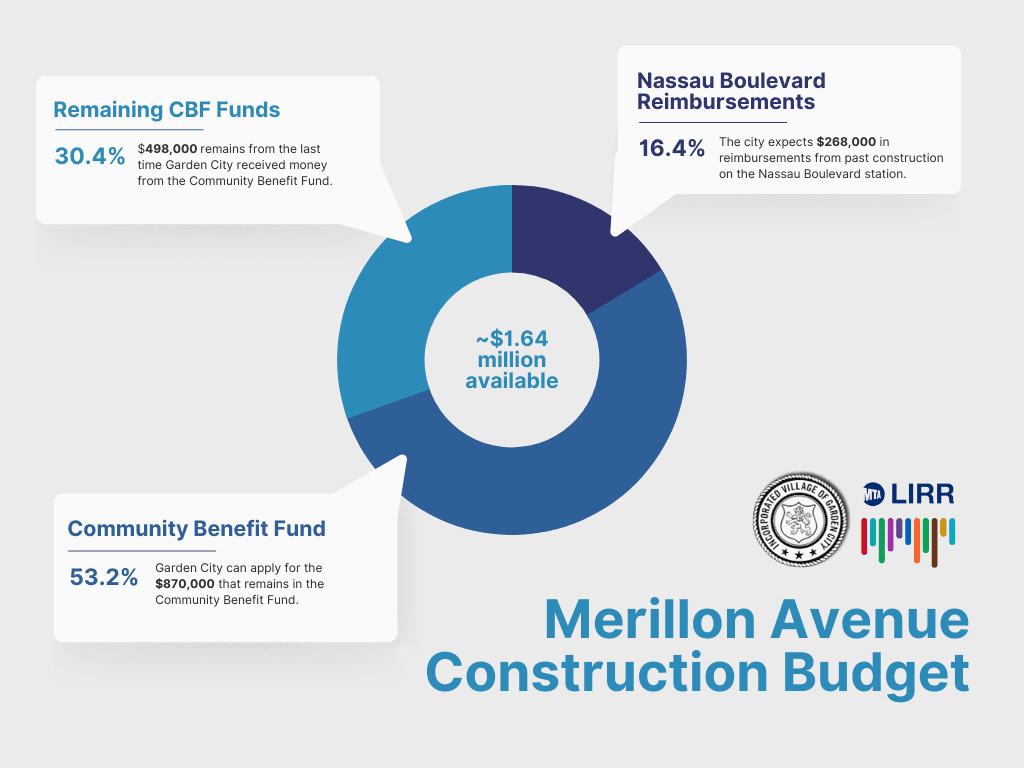By Anna DeGoede
The Village of Garden City Board passed a $1.4 million conceptual plan Oct. 13 to merge landscaped islands around the Merillon Avenue Long Island Rail Road station to allow for planting of trees and shrubs to shield the surrounding neighborhood from light and sound emitted by the station.
The project, which will take place between Merillon and Main avenues, will also add sidewalks.
The plan was developed in collaboration with local engineers and community members, including LIRR engineer Paul Rothenbiller, of Garden City, who provided feedback and made adjustments to the plan while it was in development.
In merging islands, Euston Road, measuring only a short distance, will be closed, according to Village Administrator Ralph Suozzi, who presented the plan to the village board at the meeting. Previously, at the Sept. 15 board meeting, council members voted 8-0 and determined that closing the road would not impede traffic.
Celia Petersen, a professional landscape architect, is among those tasked with identifying the species and placement of trees that will be planted to create the barrier between the station and the neighborhood.

There will also be light shields placed on the westbound side of the station. “The village is looking to have the platform lights shielded with what [are] referred to as baffles to reduce the bleeding of light horizontally into the neighborhood to the south of the platform,” said Suozzi in a written interview. “The shielding maintains the light downward, where it is needed for passenger safety and visibility on the platform.”
Various utility lines will be impacted by construction at the station, but the lines are deemed non-essential or will be adjusted as necessary. Three utility lines have been identified, Suozzi said: water, gas and a 6–to-8-inch sewer line extending underground from the boiler room that heats the platform in the winter. Since the sewer line is not used to carry human waste away from the surrounding area, construction can take place around it, according to Suozzi.
With this construction project, residents can also expect modified drainage, angled parking, more handicapped spaces and a possible added stop sign for oncoming Nassau Boulevard traffic.
The project is to be largely paid for through the Community Benefit Fund (see below). Combined, available funds amount to about $1.64 million — enough to pay for the estimated $1.4 million construction project around Merillon Avenue.

The estimated cost for the project is based off 31 road paving bids. The cost might also change depending on repairs needed for damaged sidewalks and landscaping, which is not currently included in the $1.4 million budget. Costs could go up, but they could also decrease, officials said.
Certain board members said they were concerned about the still-emerging details around cost, traffic and landscaping.
Meanwhile, Garden City Mayor Cosmo Veneziale said, “I think the concept should be approved. I think it should be contingent on making sure we’re able to do this.”
Ultimately, the board voted to approve the conceptual plan while requiring updates on it as more concrete details arise. Among the details to be finalized is a meeting with LIRR contractor 3rd Track Constructors to determine the organization’s contractual obligations for construction; after the meeting, the Village of Garden City will be able to officially apply for Community Benefit Fund support.
“The approval tonight will be for the conceptual plan moving forward, but there will then be a subsequent implementation resolution that would need to occur once the actual costs are determined and the allocation of funds” is made, Trustee Bruce Torino said.









